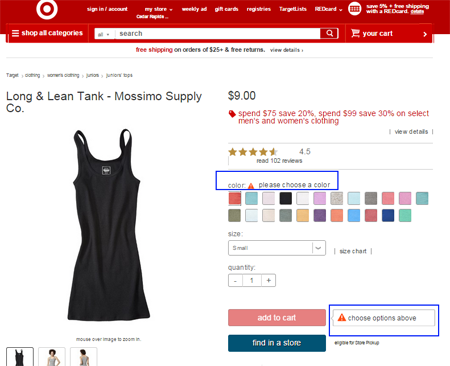
1. Making improvements without high traffic/ conversions
Some clients have this misconception that CRO = testing. Not all websites are fit for testing, however. Daniel clarifies that if there’s less than 20,000 uniques a month, you won’t be able to successfully run even a simple AB test.
Tim, on the other hand, talks about it in terms of conversion actions and recommends a lower threshold of 10 conversion actions a day even for the simplest AB test. He notes that even with a high traffic rate, if most of your visitors are tire-kickers and nobody’s filling out your form or buying your stuff, you can’t run tests.
If the client doesn’t have the numbers, focus on conversion audits instead. Recommend changes based on your experience and usability best practices. Since the changes can’t be tested, suggest watching the analytics after the implementation.
Convincing the client that what you’re suggesting works in most cases could be a bit of a challenge since you have no data to back it up. This is where case studies come into play; this is where you rely on circumstances and specific quantifiable test results of where the recommendation has worked in higher volume environments in the past.
And sometimes, Daniel points out, the logic behind the best practice just stands.
If you’re running a test on an e-commerce product page, for example, a lot of out of the box set-ups will have an issue with the product page selector not having a defaulted attribute selected for the user. For instance, customers get an error after clicking the add-to-cart button if they fail to choose the color of the product. This results in micro-frustration as users assume that whatever color they’re seeing is selected. Here the better approach is apparent, as clients wouldn’t want customers to be frustrated by the error and the extra action they have to take because of the lack of a default selection.
Users assume that whatever color they’re seeing is pre-selected. When customers get an error after clicking the add-to-cart button because they failed to choose the color of the product, it will result in frustration.
2. Getting qualitative insights
Daniel shares that, as much as possible, they customize their approach specific to the experience that’s on the client’s site. This involves conducting remote usability studies where they have users go through different scenarios and making recommendations to the client based on how people interact with the site (e.g. where people ran into issues or where they had troubles).
For remote usability studies, there are tools you can use, so you don’t have to recruit people. UserTesting.com, for example, has a pre-selected panel of people who are trained to talk out loud and can do whatever tasks you ask them to do on your website.
You can also get feedback through an on-site micro-survey or polling tools like Qualaroo.
Tim stresses that most people think only of quantitative measurable things, but a lot of the insights (even for what to test) come from qualitative looks at people, not statistics-based stuff.
3. Working with IT
To effectively administer a testing program for a client, it has to be a very collaborative process. Daniel shares that typically, earlier in the process, they stick to making front-end changes that they can impact through JavaScript or jQuery by using tools like Visual Web Optimizer.
From these changes, you can get great conversion lifts, and you wouldn’t need heavy IT involvement yet.
However, after you’ve had your quick wins, you’ll eventually need to change the way the website fundamentally works and how data’s being called from the backend of the site. This is where things can slow down, because you need heavy IT involvement, and they may not be thrilled that you’re adding tasks to their already full plate.
There are two things you need to make sure you do for this stage. First, you need to make sure you have a few wins under your belt, and a champion within the company – that will enable you to get more done. Second, you need to give IT credit every step of the way – if they get seen as rock stars because they have an impact on the bottom line, your next tasks with them will be smoother.
Need Help With Your Conversion Optimization Program?
Get strategic support for CRO program development, capability audits, and staff training. Learn how SiteTuners can help you
4. Watching out for technical and visual execution problems
A lot of times, you can’t know how the structure of the client’s databases and how the parts of the back end work.
On the other hand, to get visual execution done right, there’s a lot of iteration involved. If you’re implementing some trust mark on the site, for instance, and you want it on the footer then repeated in certain locations in the checkout process, this might not make sense to the client, and they might think that you don’t intend to repeat it so much (when in fact you’re doing this deliberately, as it’s going to have a certain conversion outcome).
The same is true for the long form sales format. One of the things that Eight by Eight CEO Amy Africa stresses is that you need to think in terms of screenfuls. This means that if the page is scrolling, you have to either keep it on the page in a non-scrollable position or repeat it over and over again. People might think it’s redundant, but it’s an example of a CRO insight that’s not necessarily obvious to the people implementing.
Be wary too of clients trying to implement an elaborated version of a winning test. In cases like this, you have to educate them that if they want to elaborate on an idea, that should also be tested in the future.
5. Learning from the experts
Reading case studies can only get you so far. Daniel shares that when he was starting out, he’d apply some ideas and best practices, but his test would fail. It wasn’t really until he got a mentor that helped him learn from their experience what works and doesn’t in conversion optimization that he started having a lot more success as an optimizer.
He recommends finding some of the experts on LinkedIn and telling them that they’re in a position that you want to be in someday. You can take them out to coffee to learn how they got there and ask them a few questions about they evolved from what they were doing before to what they’re doing now, so you can hopefully take the same route someday and become a CRO specialist.


